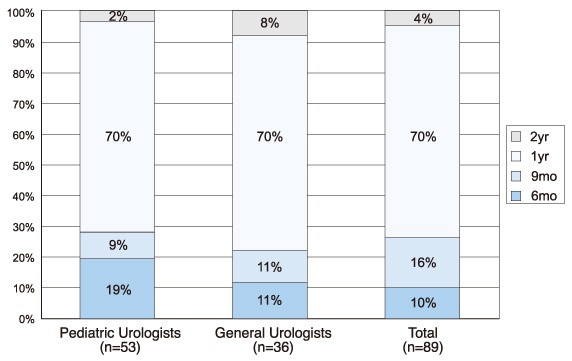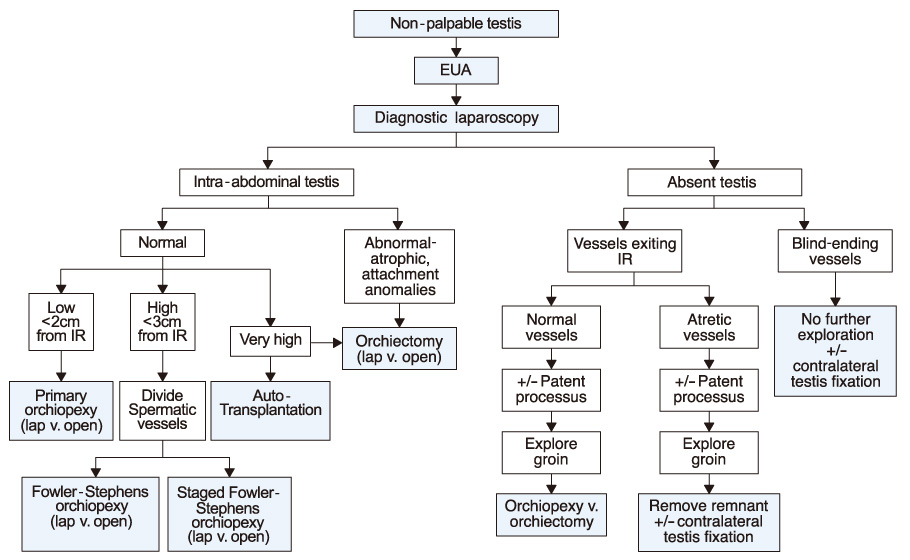J Korean Med Assoc.
2008 Jul;51(7):643-650. 10.5124/jkma.2008.51.7.643.
Diagnosis and Management of Cryptorchidism
- Affiliations
-
- 1Department of Urology, Sungkyunkwan University School of Medicine, Korea. dsryumd@yahoo.com
- KMID: 2185915
- DOI: http://doi.org/10.5124/jkma.2008.51.7.643
Abstract
- Cryptorchidism or an undescended testis is one of the most common congenital anomalies found at birth and affects about 3% of full-term male newborns. A cryptorchid testis can be located anywhere between the abdominal cavity and just outside the scrotum, and 80% of undescended testes are palpable. Approximately three-fourths of cryptorchid testes will spontaneously descend, usually by 3 months of age. Children with retractile testes require annual follow-up until puberty or the testis is no longer retractile. Determination of whether the testis is present on physical examination is critically important because it guides further workup and treatment. Although radiological evaluation does not have a relevant role in the assessment of undescended testes and would not influence surgical management, many physicians have been performed it to verify the location and condition of cryptorchid testis. The efficacy of hormonal treatment is less than 20% and is significantly dependent on pretreatment testicular location. Therefore, surgical repositioning of the testis within the scrotal sac, i.e., orchiopexy, remains the gold standard for the management of undescended testes and it should be performed between 6 and 12 months of age because spontaneous descent occurs uncommonly thereafter, and in order to prevent the complications and long-term sequelae of cryptorchidism, such as testicular torsion, trauma, infertility, and testicular cancer. Recently, laparoscopy has attained its greatest degree of general acceptance, both diagnostically and therapeutically, in the realm of pediatric urology for the management of a nonpalpable testis.
Keyword
MeSH Terms
Figure
Reference
-
1. Schneck FX, Bellinger MF. Wein AJ, Kavoussi LR, Novick AC, Partin AW, Peters CA, editors. Abnormalities of the testes and scrotum and their surgical management. Campbell-Walsh urology. 2007. 9th ed. Philadelphia: WB Saunders;3761–3798.2. Scorer CG. The descent of the testis. Arch Dis Child. 1964. 39:605–609.
Article3. John Radcliffe Hospital Cryptorchidism Study Group. Cryptorchidism: a prospective study of 7500 consecutive male births, 1984-8. Arch Dis Child. 1992. 67:892–899.4. Khuri FJ, Hardy BE, Churchill BM. Urologic anomalies associated with hypospadias. Urol Clin North Am. 1981. 8:565–571.
Article5. Jones ME, Swerdlow AJ, Griffith M, Goldacre MJ. Prenatal risk factors for cryptorchidism: a record linkage study. Paediatr Perinat Epidemiol. 1998. 12:383–396.
Article6. Elert A, Jahn K, Heidenreich A, Hofmann R. The familiar undescended testis. Klin Padiatr. 2003. 215:40–45.7. Hadziselimovic F, Thommen L, Girarad J, Herzog B. The significance of postnatal gonadotropin surge for testicular development in normal and cryptorchid testes. J Urol. 1986. 136:274–276.
Article8. Park JW, Kim KS. Incidence, risk factors and spontaneous descent of cryptorchidism. Korean J Urol. 2003. 44:1203–1207.9. Wenzler DL, Bloom DA, Park JM. What is the rate of spontaneous testicular descent in infants with cryptorchidism? J Urol. 2004. 171:849–851.
Article10. Kaplan GW. Nomenclature of cryptorchidism. Eur J Pediatr. 1993. 152:17–19.
Article11. Barthold JS, Gonzalez R. The epidemiology of congenital cryptorchidism, testicular ascent and orchiopexy. J Urol. 2003. 170:2396–2401.
Article12. Kolon TF, Patel RP, Huff DS. Cryptorchidism: diagnosis, treatment, and long-term prognosis. Urol Clin North Am. 2004. 31:469–480.
Article13. Hrebinko RL, Bellinger MF. The limited role of imaging techniques in managing children with undescended testes. J Urol. 1993. 150:458–460.
Article14. Ryu DS, Lee SW, Kim KS, Chang HS. Task force team result presentation: cryptorchidism/undescended testis. Korean Soc Ped Urol. 2008. 75–83.15. Snodgrass WT, Yucel S, Ziada A. Scrotal exploration for unilateral nonpalpable testis. J Urol. 2007. 178:1718–1721.
Article16. Ryu DS, Kim GH, Kim KS. A case of bilateral vanishing testes syndrome. Korean J Urol. 1993. 34:733–736.17. Chilvers C, Dudley NE, Gough MH, Jackson MB, Pike MC. Undescended testis: the effect of treatment and subsequent risk of subfertility and malignancy. J Pediatr Surg. 1986. 21:691–696.
Article18. Walsh TW, Dall'Era MA, Croughan MS, Carroll PR, Turek PJ. Prepubertal orchiopexy for cryptorchidism may be associated with lower risk of testicular cancer. J Urol. 2007. 178:1440–1446.
Article19. Pettersson A, Richiardi L, Nordenskjold A, Kaijser M, Akre O. Age at surgery for undescended testis and risk of testicular cancer. N Engl J Med. 2007. 356:1835–1841.
Article20. Han SW, Lee T, Kim JH, Choi SK, Cho NH, Han JY. Pathological difference between retractile and cryptorchid testes. J Urol. 1999. 162:878–880.
Article21. Kim TK, Lee SD, Cho BM, Kim SY, Kim JS. Report on the patient parents' understanding and the pediatricians' understanding of cryptorchidism: the optimal time for surgical correction. Korean J Urol. 2005. 46:1290–1301.22. Capello SA, Giorgi LJ Jr, Kogan BA. Orchiopexy practice patterns in New York State from 1984 to 2002. J Urol. 2006. 176:1180–1183.
Article23. Caruso AP, Walsh RA, Wolach JW, Koyle MA. Single scrotal incision orchiopexy for the palpable undescended testicle. J Urol. 2000. 164:156–159.
Article24. Docimo SG. The results of surgical therapy for cryptorchidism: a literature review and analysis. J Urol. 1995. 154:1148–1152.
Article25. Rajfer J, Walsh PC. Hormonal regulation of testicular descent: experimental and clinical observations. J Urol. 1977. 118:985–990.
Article26. Pyörälää S, Huttunen NP, Uhari M. A review and meta-analysis of hormonal treatment of cryptorchidism. J Clin Endocrinol Metab. 1995. 80:2795–2799.
Article27. Rajfer J, Handelsman DJ, Swerdloff RS, Hurwitz R, Kaplan H, Vandergast T, Ehrlich RM. Hormonal therapy of cryptorchidism. A randomized, double-blind study comparing human chorionic gonadotropin and gonadotropin-releasing hormone. N Engl J Med. 1986. 314:466–470.
- Full Text Links
- Actions
-
Cited
- CITED
-
- Close
- Share
- Similar articles
-
- Comprehension and Practice Patterns Toward Cryptorchidism in Korean Urologists
- Individualized Treatment Guidelines for Postpubertal Cryptorchidism
- 5 cases of the Cryptorchidism Treated with Hormonal Therapy (H.C.G.)
- Epidemiologic Study of the Prevalence and Awareness of Cryptorchidism, Hydrocele, and Varicocele in Elementary Schools in Gwangju
- Hormonal Therapy on Cryptorchidism



